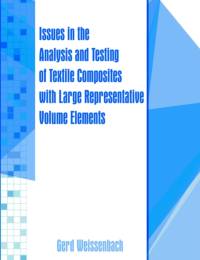Om Issues in the Analysis and Testing of Textile Composites with Large Representative Volume Elements
The high degree of heterogeneity of textile composites was found to be the primary problem in analysis and testing. A concept was developed based on a description of the local variation of the material stiffness matrix using a spline interpolation. The role of this stiffness function is to facilitate the calculation of the material stiffness matrix at any given position or for arbitrary domains in the form of finite elements.Based on this approach, two different methods were developed. In the first method the average material stiffness matrix is calculated for a finite element and subsequently the elemental stiffness matrix of this element is assembled. In the second approach the elemental stiffness matrix is calculated directly using the local material stiffness at the integration points of the finite element.
This concept was then applied to the plate twist test. The numerical analysis of this test was done in order to determine the influence of heterogeneity on the test results. It was shown that this test measures the in-plane shear modulus largely independent of the representative volume element (RVE) size. Both finite element approaches were then applied to the V-notched beam shear test, to investigate the applicability of this test to the measurement of the shear properties. The test set-up as well as numerical parameters of the finite element analysis of the test were studied. It was possible to derive limits for the applicability of the V-notched beam shear test in terms of RVE size, as well as set up guidelines for the finite element analysis of textile composites.
With electronic speckle pattern interferometry, which enables full-field displacement and strain measurements, tensile tests were carried out on 3D-woven textile composite specimens. With the agreement of the experimental results and the theoretical predictions the validity of the developed approach was again shown.
Visa mer

